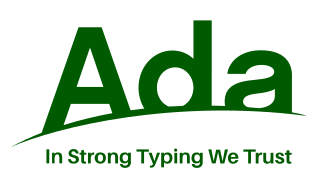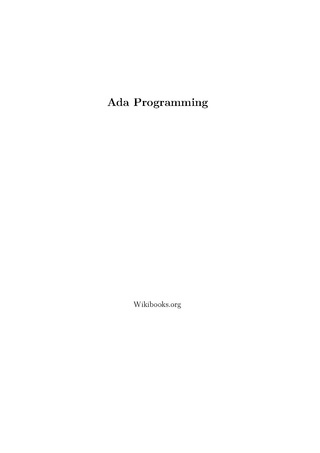
Ada is a structured, statically typed, imperative, and object-oriented high-level programming language, inspired by Pascal and other languages. It has built-in language support for design by contract (DbC), extremely strong typing, explicit concurrency, tasks, synchronous message passing, protected objects, and non-determinism. Ada improves code safety and maintainability by using the compiler to find errors in favor of runtime errors. Ada is an international technical standard, jointly defined by the International Organization for Standardization (ISO), and the International Electrotechnical Commission (IEC). As of May 2023, the standard, called Ada 2022 informally, is ISO/IEC 8652:2023.
An integrated development environment (IDE) is a software application that provides comprehensive facilities for software development. An IDE normally consists of at least a source-code editor, build automation tools, and a debugger. Some IDEs, such as IntelliJ IDEA, Eclipse and Lazarus contain the necessary compiler, interpreter or both; others, such as SharpDevelop and NetBeans, do not.
In computer science, static program analysis is the analysis of computer programs performed without executing them, in contrast with dynamic program analysis, which is performed on programs during their execution in the integrated environment.
A software bug is a bug in computer software.
In computer science, program analysis is the process of automatically analyzing the behavior of computer programs regarding a property such as correctness, robustness, safety and liveness. Program analysis focuses on two major areas: program optimization and program correctness. The first focuses on improving the program’s performance while reducing the resource usage while the latter focuses on ensuring that the program does what it is supposed to do.
System software is software designed to provide a platform for other software. Examples of system software include operating systems (OS).
The following outline is provided as an overview of and topical guide to software engineering:
A programming tool or software development tool is a computer program that software developers use to create, debug, maintain, or otherwise support other programs and applications. The term usually refers to relatively simple programs, that can be combined to accomplish a task, much as one might use multiple hands to fix a physical object. The most basic tools are a source code editor and a compiler or interpreter, which are used ubiquitously and continuously. Other tools are used more or less depending on the language, development methodology, and individual engineer, often used for a discrete task, like a debugger or profiler. Tools may be discrete programs, executed separately – often from the command line – or may be parts of a single large program, called an integrated development environment (IDE). In many cases, particularly for simpler use, simple ad hoc techniques are used instead of a tool, such as print debugging instead of using a debugger, manual timing instead of a profiler, or tracking bugs in a text file or spreadsheet instead of a bug tracking system.

The Ada Semantic Interface Specification (ASIS) is a layered, open architecture providing vendor-independent access to the Ada Library Environment. It allows for the static analysis of Ada programs and libraries. It is an open, published interface library that consists of the Ada environment and their tools and applications.
DDC-I, Inc. is a privately held company providing software development of real-time operating systems, software development tools, and software services for safety-critical embedded applications, headquartered in Phoenix, Arizona. It was first created in 1985 as the Danish firm DDC International A/S, a commercial outgrowth of Dansk Datamatik Center, a Danish software research and development organization of the 1980s. The American subsidiary was created in 1986. For many years, the firm specialized in language compilers for the programming language Ada.

ARTAS is a system designed by Eurocontrol to operationally support Aerial surveillance and Air traffic control by establishing an accurate Air Situation Picture of all traffic over a pre-defined geographical area and then distributing the relevant surveillance information to a community of user systems.

RMCDE is the name of a system designed to distribute the surveillance information to a community of user systems.

CIMACT is EUROCONTROL's Civil-Military Air Traffic Management Co-ordination Tool.
MALPAS is a software toolset that provides a means of investigating and proving the correctness of software by applying a rigorous form of static program analysis. The tool uses directed graphs and regular algebra to represent the program under analysis. Using the automated tools in MALPAS an analyst can describe the structure of a program, classify the use made of data and provide the information relationships between input and output data. It also supports a formal proof that the code meets its specification.
SQALE is a method to support the evaluation of a software application source code. It is a generic method, independent of the language and source code analysis tools, licensed under the Creative Commons Attribution-NonCommercial-NoDerivs 3.0 Unported license. Software editors can freely use and implement the SQALE method.
AbsInt is a software-development tools vendor based in Saarbrücken, Germany. The company was founded in 1998 as a technology spin-off from the Department of Programming Languages and Compiler Construction of Prof. Reinhard Wilhelm at Saarland University. AbsInt specializes in software-verification tools based on abstract interpretation. Its tools are used worldwide by Fortune 500 companies, educational institutions, government agencies and startups.
TeleSoft, Inc. was an American software development company founded in 1981 and based in San Diego, California, that specialized in development tools for the Ada programming language.

TLD Systems, Ltd. was an American software company active in the 1980s and 1990s and based in Torrance, California, that specialized in language compilers for the JOVIAL and Ada programming languages that were targeted to embedded systems.





